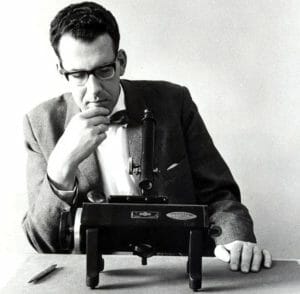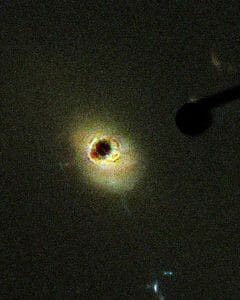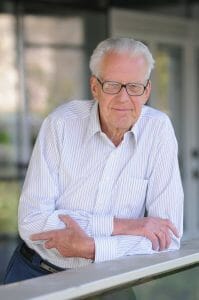A Professor of Astronomy at the California Institute of Technology for most of his career, Schmidt is best known for a gigantic leap in thinking. Quasars, short for “quasi-stellar radio sources,” were discovered in the 1950s — regularly timed bursts of radio energy coming from space — but what they were and exactly where they were was still a mystery in the early 1960s; astronomers figured they must be somewhere within our Milky Way galaxy. One found in the 1950s was dubbed 3C 273. In 1962, astronomers Cyril Hazard and John Bolton, using the Parkes Radio Telescope in Australia, gathered detailed data about 3C 273, including its exact position in the sky. They sent their data to other astronomers, including Schmidt at Caltech, who got to work. One thing Schmidt did: since he had the exact position in the sky where 3C 273 was, he went to Caltech’s Mt. Palomar observatory and looked — and he could see something there! [See photo below.] Not only was 3C 273 emitting radio pulses, it emitted light, which meant he could get spectra of that light, which scientists can use to determine the composition of what is emitting the light. But the spectra signatures didn’t line up with any known substances.

Perplexed, Schmidt set the data aside to ponder it — for weeks. It suddenly hit him in 1963: the spectra would make sense if the Doppler effect were taken into account — a “red shift” of the spectra would happen if the object was moving away from us at very high speed, just as the Doppler effect explains why a train whistle sounds lower when it’s moving away. Even better, by measuring the extent of the shift, that speed could be calculated, and even better than that, having a precise measurement of the speed would allow the object’s distance from us to be calculated. Sure enough, by accounting for such a shift, the spectra aligned to expected substances, but the resulting speed calculation was mind-boggling: 30,000 miles a second. That meant 3C 273 was about 2.4 billion light years away, or 14.1 billion trillion miles (22.7 billion trillion km). That not only put 3C 273 way, way outside the Milky Way, it’s actually today still the farthest known object visible in ground-based telescopes. And if it could be seen from Earth when it’s that far away, it had to be tremendously bright: if it was brought to 10 parsecs (34 light years) away from us, 3C 273 would be about as bright as our sun, which is only 8.3 light minutes away. And if it was that bright, a quasar can’t be a star, it had to be powered by a supermassive black hole, and the visible portion had to be an entire galaxy swirling around that black hole.

Schmidt’s answers created a sensation, not only blowing the minds of astronomers, but eventually even among the public. He was on the cover of Time magazine, and the article inside about what he had figured out and how he did it was 7,800 words long. “Just as Galileo set the stage for Sir Isaac Newton, who compiled the laws of planetary motion and gravitation, Schmidt and his colleagues are forcing their contemporaries to exercise their inventive imaginations merely to comprehend what the great observatories have seen, and the clues collected from faint spectrograms may lead science into a new era of understanding,” Time gushed. “If astronomers can find an explanation for the birth of quasars, they may yet be able to find the secrets of Creation itself.”

Caltech put it more briefly: “Schmidt’s work gave astronomers a deep insight into the history of our universe.” And, they added, “Since this pivotal observation in 1963, thousands of quasars have been identified,” providing more and even deeper insights. In 1990, Schmidt was asked that if he were God, how would he have built the universe? Even though he was an atheist, he was happy to answer: “I would have constructed a bigger universe. I think the universe is small.” It is when you think as big as Dr. Schmidt. He died at his home in Fresno, Calif., on September 17, at 92.
